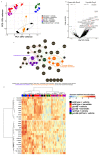Multiomics of GCN4-Dependent Replicative Lifespan Extension Models Reveals Gcn4 as a Regulator of Protein Turnover in Yeast
- PMID: 38003352
- PMCID: PMC10671045
- DOI: 10.3390/ijms242216163
Multiomics of GCN4-Dependent Replicative Lifespan Extension Models Reveals Gcn4 as a Regulator of Protein Turnover in Yeast
Abstract
We have shown that multiple tRNA synthetase inhibitors can increase lifespan in both the nematode C. elegans and the budding yeast S. cerevisiae by acting through the conserved transcription factor Gcn4 (yeast)/ATF-4 (worms). To further understand the biology downstream from this conserved transcription factor in the yeast model system, we looked at two different yeast models known to have upregulated Gcn4 and GCN4-dependent increased replicative lifespan. These two models were rpl31aΔ yeast and yeast treated with the tRNA synthetase inhibitor borrelidin. We used both proteomic and RNAseq analysis of a block experimental design that included both of these models to identify GCN4-dependent changes in these two long-lived strains of yeast. Proteomic analysis of these yeast indicate that the long-lived yeast have increased abundances of proteins involved in amino acid biosynthesis. The RNAseq of these same yeast uncovered further regulation of protein degradation, identifying the differential expression of genes associated with autophagy and the ubiquitin-proteasome system (UPS). The data presented here further underscore the important role that GCN4 plays in the maintenance of protein homeostasis, which itself is an important hallmark of aging. In particular, the changes in autophagy and UPS-related gene expression that we have observed could also have wide-ranging implications for the understanding and treatment of diseases of aging that are associated with protein aggregation.
Keywords: ATF-4; ATF4; Gcn4; autophagy; tRNA synthetase; ubiquitin–proteasome system.
Conflict of interest statement
The authors declare no competing interests.
Figures



Similar articles
-
Induction of proteasomal activity in mammalian cells by lifespan-extending tRNA synthetase inhibitors.Geroscience. 2024 Apr;46(2):1755-1773. doi: 10.1007/s11357-023-00938-8. Epub 2023 Sep 25. Geroscience. 2024. PMID: 37749371 Free PMC article.
-
Elevated proteasome capacity extends replicative lifespan in Saccharomyces cerevisiae.PLoS Genet. 2011 Sep;7(9):e1002253. doi: 10.1371/journal.pgen.1002253. Epub 2011 Sep 8. PLoS Genet. 2011. PMID: 21931558 Free PMC article.
-
Cytosolic and mitochondrial tRNA synthetase inhibitors increase lifespan in a GCN4/atf-4-dependent manner.iScience. 2022 Oct 21;25(11):105410. doi: 10.1016/j.isci.2022.105410. eCollection 2022 Nov 18. iScience. 2022. PMID: 36388960 Free PMC article.
-
Is Gcn4-induced autophagy the ultimate downstream mechanism by which hormesis extends yeast replicative lifespan?Curr Genet. 2019 Jun;65(3):717-720. doi: 10.1007/s00294-019-00936-4. Epub 2019 Jan 23. Curr Genet. 2019. PMID: 30673825 Free PMC article. Review.
-
Translational regulation of GCN4 and the general amino acid control of yeast.Annu Rev Microbiol. 2005;59:407-50. doi: 10.1146/annurev.micro.59.031805.133833. Annu Rev Microbiol. 2005. PMID: 16153175 Review.
Cited by
-
Molecular mechanisms of genotype-dependent lifespan variation mediated by caloric restriction: insight from wild yeast isolates.Front Aging. 2024 Jul 11;5:1408160. doi: 10.3389/fragi.2024.1408160. eCollection 2024. Front Aging. 2024. PMID: 39055969 Free PMC article.
-
Molecular Mechanisms of Genotype-Dependent Lifespan Variation Mediated by Caloric Restriction: Insight from Wild Yeast Isolates.bioRxiv [Preprint]. 2024 May 25:2024.03.17.585422. doi: 10.1101/2024.03.17.585422. bioRxiv. 2024. Update in: Front Aging. 2024 Jul 11;5:1408160. doi: 10.3389/fragi.2024.1408160. PMID: 38559208 Free PMC article. Updated. Preprint.
References
-
- McCormick M.A., Delaney J.R., Tsuchiya M., Tsuchiyama S., Shemorry A., Sim S., Chou A.C.-Z., Ahmed U., Carr D., Murakami C.J., et al. A Comprehensive Analysis of Replicative Lifespan in 4,698 Single-Gene Deletion Strains Uncovers Conserved Mechanisms of Aging. Cell Metab. 2015;22:895–906. doi: 10.1016/j.cmet.2015.09.008. - DOI - PMC - PubMed
MeSH terms
Substances
Grants and funding
LinkOut - more resources
Full Text Sources
Molecular Biology Databases

